Have you removed the plug beside your thermostat housing and hooked up a bypass hose as shown in seabronc's first picture? The function of a bypass hose is to move more water than can be sent through the thermostat. By plugging it off you are restricting the flow to the radiator. Forgive me if I have misunderstood what you meant by "corrected the tube routing".Still having the gradually rising temp needled even after I corrected the tube routing at the water pump./emoticons/[email protected] 2x" width="20" height="20" />
You are using an out of date browser. It may not display this or other websites correctly.
You should upgrade or use an alternative browser.
You should upgrade or use an alternative browser.
Gradually rising temperature
- Thread starter B-Co Kid
- Start date
Disclaimer: Links on this page pointing to Amazon, eBay and other sites may include affiliate code. If you click them and make a purchase, we may earn a small commission.
B-Co Kid
Member
- Joined
- Oct 14, 2010
- Messages
- 235
- Reaction score
- 8
Seabronc, I never let it overheat to that extent, once it got a little past the "L" in NORMAL, I would just shut it down because I didnt want
to risk damaging anything. Nelbur, all of the bypass stuff hasnt been there for a while, and im not sure it even applies since I have an aftermarket
intake. Actually i think i found the problem, and maybe you guys can help me out. I think the thermostat may have been installed incorrectly when
they rebuilt my engine. Pic 1 shows the thermostat as it was installed when i pulled the housing off (the thermostat in the pic is the new thermostat,
but im using it to show the position of the old one.) The writing stamped on the old thermostat indicates the thermostat should be installed as in Pic 2.
I think this could be my problem, any suggestions would be appreciated.
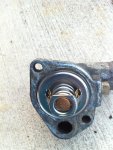
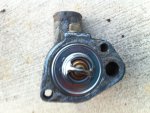
to risk damaging anything. Nelbur, all of the bypass stuff hasnt been there for a while, and im not sure it even applies since I have an aftermarket
intake. Actually i think i found the problem, and maybe you guys can help me out. I think the thermostat may have been installed incorrectly when
they rebuilt my engine. Pic 1 shows the thermostat as it was installed when i pulled the housing off (the thermostat in the pic is the new thermostat,
but im using it to show the position of the old one.) The writing stamped on the old thermostat indicates the thermostat should be installed as in Pic 2.
I think this could be my problem, any suggestions would be appreciated.


yo B,
Thermostat still-in-place prior to remova"l
"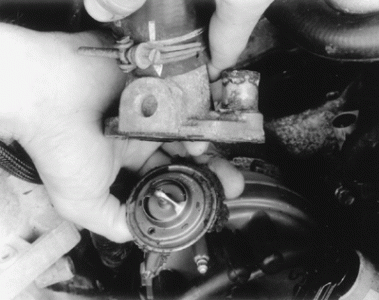
Thermostat still-in-place prior to remova"l
"

- Clean the water outlet water hose connection gasket surfaces. Coat a new water hose connection gasket with Perfect Seal Sealing Compound B5A-19554-A or D7AZ-19554-BA or equivalent meeting Ford specifications ESR-M18P2-A or ESE-M4G115-A.
- Position the water hose connection gasket on the intake manifold or cylinder head opening.
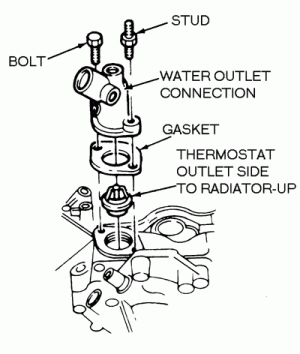
- Install the water thermostat in the intake manifold opening with the copper pellet or element toward the engine and the thermostat ****** positioned in the recess. If the water thermostat is improperly installed, it will cause a ******** flow of coolant.
- Position the water hose connection against the intake manifold and install attaching bolts. If a 7.5L engine, tighten bolts to 32-37 Nm (23-38 lb-ft). For all other engines, tighten bolts to 16-24 Nm (12-18 lb-ft).
- Install the water bypass line and tighten hose connections.
- Fill and bleed the cooling system
Last edited by a moderator:
B-Co Kid
Member
- Joined
- Oct 14, 2010
- Messages
- 235
- Reaction score
- 8
That's exactly what I needed miesk. I guess the old one was installed correctly. The old one was a 195 degree. The new replacement is also a 195 degree. I will install it today, and flush/refill system and report back. Thanks!
yo B,'
Good!
I didn't want to pick our the correct one from your pics, because I wasn't sure due to angle of the dangle ...
GL!
Good!
I didn't want to pick our the correct one from your pics, because I wasn't sure due to angle of the dangle ...
GL!
B-Co Kid
Member
- Joined
- Oct 14, 2010
- Messages
- 235
- Reaction score
- 8
New thermostat installed. Same problem. I think maybe I should consider wrapping the headers. I don't know what else could cause the rising temp problem. Could it be the sensor?
Rons beast
Active member
- Joined
- Dec 13, 2007
- Messages
- 1,537
- Reaction score
- 15
I now firmly believe that the 195 tstat will result in temp readings higher than what you are comfortable with. I'm running a 180 in the Beast and idling in gear the gauge stays at the "M" in Fla. summer heat. I have been running the 180 stats for about 10 years....never had overheating issues, except for one failure that luckily happened in my driveway.
I know some think the running temp should be in the 190 to 200 range, but I don't like my engine to be that hot either. 180 works for me and I'm approaching 200k miles.
Good luck
I know some think the running temp should be in the 190 to 200 range, but I don't like my engine to be that hot either. 180 works for me and I'm approaching 200k miles.
Good luck
Last edited by a moderator:
B-Co Kid
Member
- Joined
- Oct 14, 2010
- Messages
- 235
- Reaction score
- 8
I know this may sound like an elementary question, but does the thermostat determine engine temp or does the engine determine engine temp. I would gladly put in a lower temp thermostat. But from my limited experience, I don't think that would help, at least not in my case..
Rons beast
Active member
- Joined
- Dec 13, 2007
- Messages
- 1,537
- Reaction score
- 15
The temperature you read on the gauge is the temp of the coolant. The tstat determines the temp of the coolant by opening at the rated temp and allowing it to be circulated through the radiator where it's heat is exchanged into the air. The coolant is then returned to the engine to absorb the heat generated in the cylinders.
If an engine is overheating it is the result of: 1- lack of proper circulation of coolant.
2-inability to exchange heat through the radiator.
3-excessive heat generated by improper combustion.
The gauge in our trucks don't indicate actual temperature of the coolant, only an indication of how hot the coolant is relative to ambient temps and excessive engine temps.
To get an actual coolant temp reading. Remove the rad cap when the engine is cold. Put a kitchen thermometer, or thermometer designed for measuring coolant temp. Run the engine and watch the temp...or if your want to be high tech a laser temp gun.
If an engine is overheating it is the result of: 1- lack of proper circulation of coolant.
2-inability to exchange heat through the radiator.
3-excessive heat generated by improper combustion.
The gauge in our trucks don't indicate actual temperature of the coolant, only an indication of how hot the coolant is relative to ambient temps and excessive engine temps.
To get an actual coolant temp reading. Remove the rad cap when the engine is cold. Put a kitchen thermometer, or thermometer designed for measuring coolant temp. Run the engine and watch the temp...or if your want to be high tech a laser temp gun.
Last edited by a moderator:
Rons beast
Active member
- Joined
- Dec 13, 2007
- Messages
- 1,537
- Reaction score
- 15
Hey Kid,
I went back over this thread. I think I caught one pic of your engine that shows a fan blade outside of the fan shroud. If that is the case, the fan is too far away from the rad. and it isn't pulling enough air through at idle especially when the rpms are so low in gear.
I went back over this thread. I think I caught one pic of your engine that shows a fan blade outside of the fan shroud. If that is the case, the fan is too far away from the rad. and it isn't pulling enough air through at idle especially when the rpms are so low in gear.
Seabronc
New member
It is possible that prior to the rebuild that your system had a 180 or 165 t-stat in it. You might also want to get yourself a gauge that reads in degrees, I never trusted the Ford gauge. Like Ron said it is only a relative indicator.
That gauge depends on a sending unit which is actually a variable resister known as a thermistor. It is very dependent on the threads of the unit making good contact with the head in order to provide a proper indication. Some people mistakenly put thread tape on the threads thinking that will prevent leaking but instead it causes the threads to make poor contact. The threads are designed to self seal as you tighten the sensor up and should not have plumbers thread tape on them or any other kind of tape or goop.
Another thing to consider is an oversize radiator: ie. in a non-A/C system, install an A/C radiator. That is what you see here on my truck with an electric fan from a Lincoln VIII 4.6L engine. Control of the fan is via a temperature probe which causes the fan to run if the temperature of the antifreeze gets above a preset level.
With that arrangement, a clean system, and a 195 t-stat the engine coolant never got more that 2 degrees above the preset which was about 198.
It would be good to know what the actual temperature of the antifreeze is.
The switch and indicator are for the fan, the gauge has nothing to do with the fan, just another of my preferences over Ford gauges. The indicator tells me when the fan solenoid is supplying power to the fan and the switch allows manual control of the fan Forced ON, Automatic, Forced OFF
 >-
>-
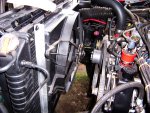
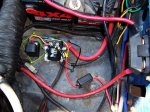
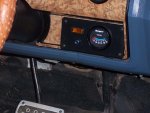

That gauge depends on a sending unit which is actually a variable resister known as a thermistor. It is very dependent on the threads of the unit making good contact with the head in order to provide a proper indication. Some people mistakenly put thread tape on the threads thinking that will prevent leaking but instead it causes the threads to make poor contact. The threads are designed to self seal as you tighten the sensor up and should not have plumbers thread tape on them or any other kind of tape or goop.
Another thing to consider is an oversize radiator: ie. in a non-A/C system, install an A/C radiator. That is what you see here on my truck with an electric fan from a Lincoln VIII 4.6L engine. Control of the fan is via a temperature probe which causes the fan to run if the temperature of the antifreeze gets above a preset level.
With that arrangement, a clean system, and a 195 t-stat the engine coolant never got more that 2 degrees above the preset which was about 198.
It would be good to know what the actual temperature of the antifreeze is.
The switch and indicator are for the fan, the gauge has nothing to do with the fan, just another of my preferences over Ford gauges. The indicator tells me when the fan solenoid is supplying power to the fan and the switch allows manual control of the fan Forced ON, Automatic, Forced OFF




Briefing thru these posts.., one thing is not covered that I could see.
WATER cools/absorbs the heat of the engine.., not the antifreeze/coolant.
Overloaning with antifreeze will cause overheating. This chemical only raises the temp at which all the liquid will "boil".
(& lowers the freeze point)
Unknown where you are but some folks add waaay too much antifreeze thinking they'll get better cooling.
Big mistake..!!
WATER cools/absorbs the heat of the engine.., not the antifreeze/coolant.
Overloaning with antifreeze will cause overheating. This chemical only raises the temp at which all the liquid will "boil".
(& lowers the freeze point)
Unknown where you are but some folks add waaay too much antifreeze thinking they'll get better cooling.
Big mistake..!!
yo B,
Your Bronco needs the 195 deg t'stat. such as;
Stant Thermostat, 195 Degrees Fahrenheit
pn 13009
http://shop.advanceautoparts.com/p/stant-thermostat-195-degrees-fahrenheit-13009/5653002-P
mechanical coolant temp gauge installed w/a T fitting in order to have both the mech and factory gauge in an 89 (same as your year
Source: by waltman at http://www.supermotors.net/registry/10222/60515
Your Bronco needs the 195 deg t'stat. such as;
Stant Thermostat, 195 Degrees Fahrenheit
pn 13009
http://shop.advanceautoparts.com/p/stant-thermostat-195-degrees-fahrenheit-13009/5653002-P
mechanical coolant temp gauge installed w/a T fitting in order to have both the mech and factory gauge in an 89 (same as your year
Source: by waltman at http://www.supermotors.net/registry/10222/60515
Seabronc
New member
Ditto what BB said. Water is much more efficient at cooling an engine, antifreeze reduces the efficiency.Briefing thru these posts.., one thing is not covered that I could see.
WATER cools/absorbs the heat of the engine.., not the antifreeze/coolant.
Overloaning with antifreeze will cause overheating. This chemical only raises the temp at which all the liquid will "boil".
(& lowers the freeze point)
Unknown where you are but some folks add waaay too much antifreeze thinking they'll get better cooling.
Big mistake..!!
That thought went through my head after posting, since that is part of my strategy for keeping the engine cooler. If you are in a hot climate, you can greatly reduce your amount of antifreeze and will get much more efficient cooling. Even if you live in the northern areas you can do that in the Summer. I keep mine below 50% in the Summer. You just don't want 100% water. You need something to keep the system from developing rust.
B-Co Kid
Member
- Joined
- Oct 14, 2010
- Messages
- 235
- Reaction score
- 8
I used approximately 50/50 water and coolant. I've flushed and refilled twice already. The temp sensor did have plumber tape on it. I replaced it with original motorcraft sensor. I also burped the cooling system, I think. I pulled the radiator cap of and let it run. There were a couple of small bubbles that I saw, nothing major. I tested the fan clutch, wiggled it, there was no looseness. Turned it by hand, it spun but with resistance. So I guess I will try wrapping the headers. I've learned from you guys, not to throw new parts at the B-Co trying to solve a problem. But I'm stumped on this one!
Seabronc
New member
I think you have us doing the same @-)But I'm stumped on this one!
I still think You should find out what the actual temperature of the coolant is when it gets to your discomfort level.
Last edited by a moderator:
Laser temp. gage at H.F. approx. $35.
My temp. gage reads low. Laser gage reads a perfect 180deg.
Just say'n... /emoticons/[email protected] 2x" width="20" height="20" />
/emoticons/[email protected] 2x" width="20" height="20" />
My temp. gage reads low. Laser gage reads a perfect 180deg.
Just say'n...
B-Co Kid
Member
- Joined
- Oct 14, 2010
- Messages
- 235
- Reaction score
- 8
How do I measure coolant temp after it gets hot? If I take the radiator cap off, hot coolant will burst out, and if I leave it off during warmup eventually coolant starts overflowing out of radiator...
yo B,
I went back to page 1 a few times and see "...I put it in gear, with brake engaged, and sit for about 5 mins in gear, the temperature gradually rises (to the L in NORMAL on the gauge). Once I start driving for a while, the temp drops back to normal (between the R and the M in NORMAL on the gauge)..."
Does it go to L while driving at a steady speed or on way to work with some short stops @ traffic lights?
================

Coolant temperature sensor temperature vs. resistance values
When coolant temperature is low, the resistance of the sending unit is high, restricting the flow of current through the gauge and moving the pointer only a short distance. As coolant temperature rises, the resistance of the sending unit decreases, causing a proportional increase in current flow through the sending unit and corresponding movement of the gauge pointer.
The sending unit may only be tested for operation. There is no calibration, adjustment or maintenance required.
Remove the sensor from the vehicle.
Immerse the tip of the sensor in container of water.
Connect a digital ohmmeter to the two terminals of the sensor.
Using a calibrated thermometer, compare the resistance of the sensor to the temperature of the water. Refer to the engine coolant sensor temperature vs. resistance illustration.
Repeat the test at two other temperature points, heating or cooling the water as necessary.
If the sensor does not meet specification, it must be replaced.
I went back to page 1 a few times and see "...I put it in gear, with brake engaged, and sit for about 5 mins in gear, the temperature gradually rises (to the L in NORMAL on the gauge). Once I start driving for a while, the temp drops back to normal (between the R and the M in NORMAL on the gauge)..."
Does it go to L while driving at a steady speed or on way to work with some short stops @ traffic lights?
================

Coolant temperature sensor temperature vs. resistance values
When coolant temperature is low, the resistance of the sending unit is high, restricting the flow of current through the gauge and moving the pointer only a short distance. As coolant temperature rises, the resistance of the sending unit decreases, causing a proportional increase in current flow through the sending unit and corresponding movement of the gauge pointer.
The sending unit may only be tested for operation. There is no calibration, adjustment or maintenance required.
Remove the sensor from the vehicle.
Immerse the tip of the sensor in container of water.
Connect a digital ohmmeter to the two terminals of the sensor.
Using a calibrated thermometer, compare the resistance of the sensor to the temperature of the water. Refer to the engine coolant sensor temperature vs. resistance illustration.
Repeat the test at two other temperature points, heating or cooling the water as necessary.
If the sensor does not meet specification, it must be replaced.
Rons beast
Active member
- Joined
- Dec 13, 2007
- Messages
- 1,537
- Reaction score
- 15
If coolant is "bursting" out of the rad, you still have an air pocket, or there is a serious hot spot in your engine. Most likely after some minor "Burping", the coolant temp. will be high enough to open the tstat, and the coolant will circulate through the radiator. It's after this circulation starts and the coolant level in the rad stabilizes, that you should measure the temp. Sometimes you need to add a bit of water to "top off" the rad. But be careful! Do not add water to the rad if you cannot see the coolant level. Turn the engine off and let things cool down first.
Similar threads
- Replies
- 0
- Views
- 636
